1
The car that... makes hybrids desirable
BMW i8
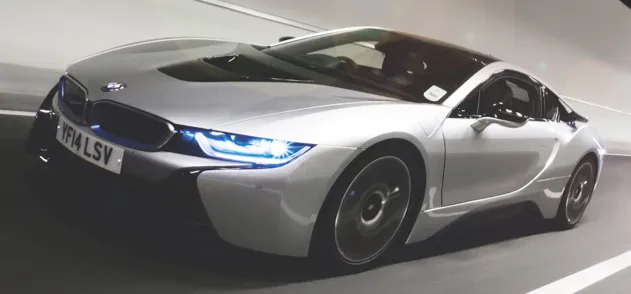
Sat in the car park of BMW’s UK headquarters, where we picked it up, the i8 looks like it belongs in a different decade from the cars surrounding it. Unlike most concept cars, its futuristic features have made it to the factory floor – so it still has gull-wing doors that open upwards, it has wings at the rear that channel air over the body and it still has those blue paint details signifying the battery under the hood. The Philip K Dick aesthetics though, beautiful as they are, are the least exciting thing about it.
Underneath the i8’s bonnet there’s a 129bhp electric motor that powers the front wheels. Meanwhile in the back, right behind the cockpit, is a 228bhp, impossibly small (1.5-litre) petrol engine sending power to the rear wheels. Somewhere in the back there’s also a third tiny electric motor that helps recharge the lithium battery. Of course, all of this equipment is quite heavy, so BMW has made the doors and passenger cell out of a new composite material - carbon fibre reinforced plastic – which is 30 per cent lighter than aluminium. This cocktail means that the BMW can be frugal with your fuel when you want it to be (BMW says it can get up to 134mpg, though we averaged a laudable 40mpg). But flick the gear lever down into Sport mode, and this combination has another use: speed.
At the flick of a switch, the instrument cluster flashes red and the petrol engine snarls behind you. This in itself is not surprising, but what happens next is. The petrol motor throws all of its grunt into spinning the rear wheels, while the electric motor hauls you forward. All petrol engines will have an optimum power range, a spectrum in the rev counter where they run most efficiently. Outside of this range the power delivery drops off sharply, but in the i8 the electric engine simply fills in the gaps, hurling you forwards with almost brutal acceleration. There is nothing quite like it.
But even that’s not what really won us over about the i8. Although this is a red-blooded sports car, its low CO2 emissions (49g/km) mean it’s exempt from road tax as well as London’s Congestion Charge. It’s also eligible for the government’s plug-in car subsidy. So this car (insurance aside) won’t kill your wallet after you’ve bought it. In fact, most of the time, since the UK’s average journey length is under seven miles, you could in theory just potter around town and hardly spend a penny, using its 37km (23-mile) EV range. It’s a money-saving combo that’s proven so popular that owners can now sell the car for double the price they originally bought it for.
2
The car that... can drive better than you
Mercedes S-Class
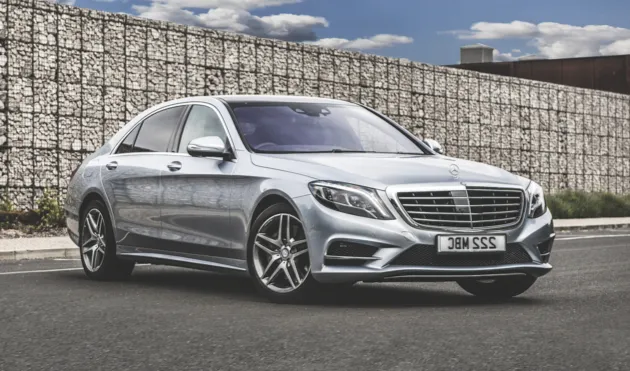
A few hours into driving the S-Class, I was rendered immobile by London’s pesky traffic. I’d thought the capital’s roads might be quiet at 11pm; I was wrong. Still, it seemed like a good chance to poke and prod some of the S-Class’s features. Twenty minutes later, I was enjoying an ‘activating hot stone massage’ from my seat, and I had ‘ionized’ the air, cleaning it of any contaminants. Bliss!
During the hour that I sat in traffic, it became clear that it was probably easier to list the features the car didn’t have than the ones it did. For instance, while the cup holders will keep your drinks cool or warm, they won’t cook a Pot Noodle. And while they have thought to fit a fridge in between the rear seats, there’s no bar to store your 30-year-old single malt. How naïve. In all seriousness, though, there are few vehicles on four wheels better equipped than the S-Class, and that’s not just because of all the luxuries it offers.
Once the traffic dissolved, I got onto the A40 and flicked on the ‘distronic’ mode. The car’s cameras took over the driving, guiding the vehicle between the white lines, blinking on the night vision on the dashboard whenever a pedestrian looked like they might cross the road. No one stepped out, fortunately, but the distraction meant I had begun to steer into the next lane. Just as the passenger side wheels grazed the white lines, the S-Class took over the controls, slowing the left wheels to pull me back into the lane before gently asking if I might need a rest. Maybe I did.
Nearer my destination in Amersham, I swapped the motorway for narrow country lanes, where I met a deer and its fawn idling in the road. Thanks to the enormous beam from the Merc’s adaptive LEDs, their eyes gleamed at me in the dark. But the night vision had already flicked again to warn me of the hazard ahead.
By the end of my time with the Mercedes S-Class, I wasn’t quite sure whether I had driven more miles or the car had. Either way, it’s only a matter of time before I’m happy to hand over the controls for good.
3
The car that... improves with age
Tesla Model S
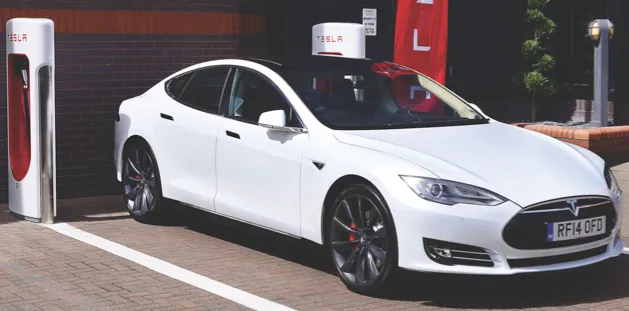
When the Tesla landed on UK shores last year, it blew us away. This pioneer proved that using batteries to power your car didn’t have to mean sacrifice. The 355km (240-mile) range won’t suit every driver, but it’s plenty for most. Indeed, this time around we got to use Tesla’s new supercharger network, and once we’d parked up and plugged in, it only took half an hour to top up. But in the time since our first drive, the car’s power train has become its least interesting aspect.
The most amazing feat of the Tesla is how it has evolved over time. Normally a petrol or diesel car stays the same once it’s left the showroom, but the Model S is different. The car is riddled with computers, and every part of the vehicle is connected to them. This means that Tesla’s engineers are able to send upgrades through the air via the car’s 3G connection. These updates download while the car’s parked up at night, so when you get back into your Model S the next morning, it’s got even better.
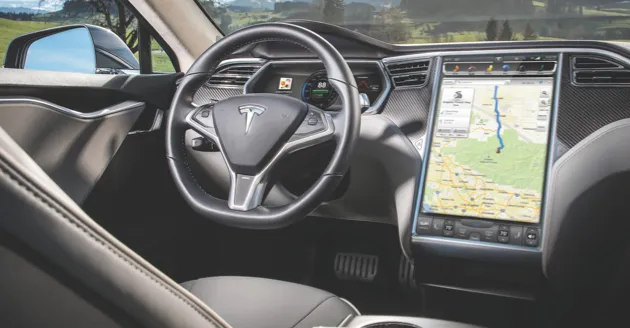
And these updates are more than superficial. For example, the last update added automatic emergency braking to the car – so that the Model S will stop if it detects you’re about to slam into something. There was also a Valet Mode added in the last update that tames the Tesla’s performance to make sure anyone else driving it behaves themselves. Best of all, some tweaking of the car’s algorithms actually made the Model S faster, shaving 0.1 seconds off its 0-60mph time.
Even more exciting is what’s to come. The next update promises to teach the car to drive itself on motorways, and come running when you ‘summon’ it from the garage. Both hint that the car is nearing the point where it’ll soon be able to drive itself entirely – its creator, Elon Musk, just has to wait for the law to catch up with his technology. And it begs the question: why can’t all our cars be upgradeable in this way?
4
The car that... removes distractions
Audi TT
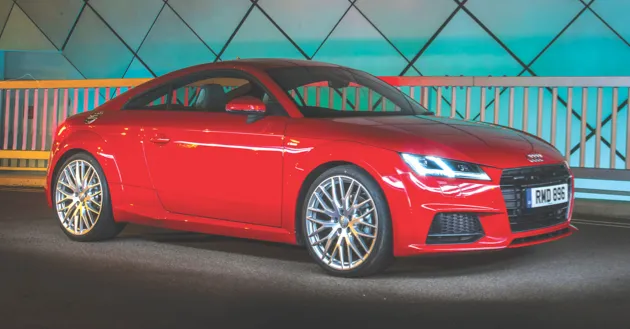
From the outside, this diminutive sports car looks like just that – a featherweight car that’ll be as light on features as it is on the scales. But the TT’s appearance belies what is an incredibly clever little machine.
The trouble with the cars we’ve mentioned so far is that, with all of their incredible features, they can be a little distracting. Doubly so, since most of these options are accessed via a central console that’s lower than the windscreen you actually should be looking at. Audi has remedied this with what it’s calling a ‘virtual cockpit’.
What this means is that behind the steering wheel sits an LCD screen that’s the motoring equivalent of an iPad. For example, when you hit the Sat-Nav button, the speedo and rev counter retreat to the sides, presenting a wonderfully detailed map. You can flick through your media and all the car’s different options and features, without ever fully diverting your attention from the road ahead. You never feel like you’re dicing with death at 70mph just because you wanted to turn the air conditioning down.
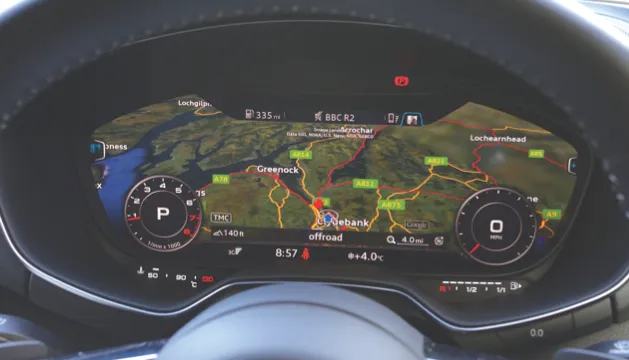
It’s also the small touches that make a big difference. For example, the dash is perfectly carved out to match the steering wheel, so no information is obscured by the wheel. The buttons are sparse but well placed, so you don’t have to look away from the road to find them. For example, the car’s temperature can be adjusted via the fans themselves. Another smart touch is the jogwheel, which has a touch-sensitive surface so you can scrawl out addresses and contacts with your fingers. These might seem like small things, but as I drove across Bristol, I soon realised that this was the best designed interior I had ever driven in.
5
The car that... could clean up our cities
Toyota i-Road

As ingenious as the previous cars were, they won’t make a dent in one of motoring’s biggest problems: congestion. Cars are choking the world’s cities and the prognosis isn’t pretty. A 2014 study by the Centre for Economics and Business Research calculated that British motorists spend four days a year sat in traffic, and that over the next 15 years congestion will cost the UK £300bn.
Toyota is trying to come up with a solution, and this is its latest attempt: the i-Road. Think of it as a motorised Boris bike with a 60km/h (37mph) top speed and a 48km (30-mile) range. The idea is you drive to the city, park up and swap your car for one of these battery-powered trikes. That might not sound great, but the i-Road makes a lot of sense.
Compared to the futuristic exterior, the interior is reassuringly familiar: there’s a steering wheel, indicators and a dashboard. But that’s where the similarities end. Steer left or right and the whole body gracefully leans over, like a speed skater shifting their weight into the corner. But unlike ice skaters, there’s no risk of falling over. As the front suspension pushes one wheel downwards, gyroscopes and inertial sensors combine to determine just how far the car can tilt. The actual steering is done by the rear wheel, which means the back swings round when you want to make a tighter angle. It all sounds, well, slightly mad, but it took all of three minutes weaving through the streets of Grenoble (the only place in Europe you can drive one) for us to fall in love.
Imagine an entire city filled with cars like the i-Road. Traffic would all but disappear, smog would clear and the streets would be blissfully quiet. This is exactly what they’re testing in Grenoble, where you can rent the car for €3 for 15 minutes and €1 for every quarter-hour after. Sadly the i-Road is still only a concept car right now, and as much as we’d love to see Bristol buzzing with little i-Roads, they’re unlikely to reach here any time soon. But Toyota has said it’s committed to the idea, so watch this space.
This article first appeared in the June 2015 issue of BBC Science Focus.
Follow Science Focus onTwitter,Facebook, Instagramand Flipboard
